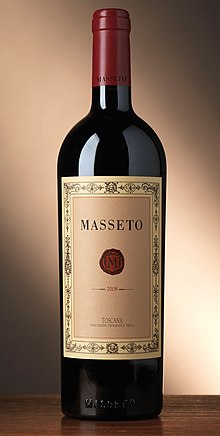Masseto
The Masseto is a cru from the seven hectare vineyard of the same name in Bolgheri , near the Tuscan coast.
location
Among the first to recognize the potential of the terroir of the Masseto hill with its ideal climatic conditions for Merlot was the Russian-American viticulture expert Andrè Thcelicheff . The proximity of the coast ensures a Mediterranean climate, which is responsible for the moderate temperatures in summer, which is beneficial for the ripening of the grapes. The Masseto hill is about 120 meters above sea level and is divided into 3 layers (Masseto Alto, Centrale and Junior). The soil consists of loose clay and sand interspersed with pebbles. Characteristic of the soil is the clay from the Pliocene, which arose as a result of climate change on the earth and the associated morphological changes in the soil. The area was once coastal marshland. Over the centuries, layers of clay interspersed with salt residues formed there. Over time, the clay soils were covered in thick deposits from the erosion of the hills. These deposits contained pebbles, sand, clay and rocks. Landslides gradually brought the Pliocene clay layers to the surface.
Vineyard
The vineyard is divided into three layers (Alto, Centrale, Junior), which differ in their soil conditions. The upper part of the hill consists of a sandy, relatively stony soil with a shallow depth. The result is a rather “straightforward” wine. The location below this is the central area of the vineyard. The high proportion of clay from the Pliocene determines the character of its soil. The wine gets its strong tannin structure from it. At the foot of the hill is the lowest part of the vineyard, the subsoil is clayey and sandy. He is responsible for a light wine that is used to harmonize the strong tannins of the other wines. In each of these three cultivation zones, the grapes ripen at different times, which is why they have to be picked separately. The rows of vines are arranged across the steepest slope of the hill so that the precipitation can slowly penetrate the soil. The vines are raised in the cordon system. The number of buds and the yield vary depending on the vine. The development of the vines depends particularly on the manual labor of the workers in the vineyard. They help them achieve their balance by pruning 5-10% of the plants.
Vinification and expansion
It takes three years from harvest to bottling. First, the berries are sorted individually on the sorting belt before and after destemming. They are then fermented in temperature-controlled stainless steel tanks and the mash is checked and tasted daily. The wines are then matured in barriques . Barrels made of oak wood with the finest grain and a medium degree of roasting, which comes from the forests of the French massif Central, are used.
Then the assemblage of the individual base wines is made. The Masseto is then poured back into the barriques, where it matures for two years. Finally, the wine is bottled; depending on the vintage, clarification can take place beforehand.
The bottles are fitted with an RFID label on the back, which means that each individual bottle can be identified, its authenticity can be proven and its trade route can be traced. The first wine to emerge from the Masseto vineyard comes from the 1986 harvest. It was then called "Merlot". Since the 1987 vintage, his label has been called "Masseto".
literature
- Robert M. Parker: Parker's Wine Buyer's Guide, 7th Edition . Simon and Schuster, New York 2008, ISBN 978-1-4391-3997-4 , p. 914.
Web links
Individual evidence
- ↑ a b c Masseto vertical: once heaven and back. In: Jens Priewe, Weinkenner GmbH, weinkenner.de. September 25, 2019, accessed October 16, 2019 .
- ↑ Masseto 2010 IGT - Tenuta dell'Ornellaia. In: Maximilian Schmalhofer, Apropos wine - Schmalhofer, aproposwein.com. 2019, accessed October 16, 2019 .


